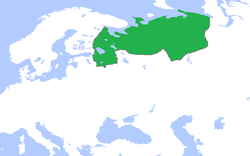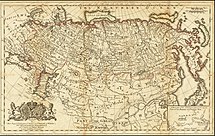 Global Information
Global InformationNovgorod Republic information
Lord's Novgorod the Great Господинъ Великiй Новгородъ | |||||||||||||
|---|---|---|---|---|---|---|---|---|---|---|---|---|---|
| 1136–1478 | |||||||||||||
 The Novgorod Republic c. 1400 | |||||||||||||
| Capital | Novgorod | ||||||||||||
| Common languages | Church Slavonic (literary) Old Novgorod dialect[a] | ||||||||||||
| Religion | Russian Orthodoxy | ||||||||||||
| Demonym(s) | Novgorodian | ||||||||||||
| Government | Mixed republic | ||||||||||||
| Prince | |||||||||||||
• 1136–1138 (first) | Sviatoslav Olgovich | ||||||||||||
• 1462–1478 (last) | Ivan III | ||||||||||||
| Legislature | Veche Council of Lords | ||||||||||||
| History | |||||||||||||
• Established | 1136 | ||||||||||||
• Disestablished | 1478 | ||||||||||||
| |||||||||||||
| Today part of | Russia | ||||||||||||
| History of Russia |
|---|
 |
|
|
The Novgorod Republic (Russian: Новгородская республика, romanized: Novgorodskaya respublika) was a medieval state that existed from the 12th to 15th centuries in northern Russia, stretching from the Gulf of Finland in the west to the northern Ural Mountains in the east. Its capital was the city of Novgorod. The republic prospered as the easternmost trading post of the Hanseatic League, and its people were much influenced by the culture of the Byzantines,[3] with the Novgorod school of icon painting producing many fine works.[4]
Novgorod won its independence in 1136 after the Novgorodians deposed their prince and the Novgorod veche began to elect and dismiss princes at its own will.[5][6] The veche also elected the posadnik, who was the chief executive of the city,[7] and from 1156, the archbishop of Novgorod, subject to approval by the Russian metropolitan.[b][8] The tysyatsky was also elected by the veche, who was originally the military commander,[9] and served the interests of the common people.[10] Novgorodian nobles known as boyars dominated the veche,[11] and the offices of posadnik and tysyatsky remained in the hands of boyar families.[8] The boyars also gave funding to the ushkuyniki, who contributed to the expansion of Novgorod's trade and colonies in the north of European Russia.[12][13]
By the 14th century, the prince of Moscow (who was almost always the grand prince of Vladimir) was usually the prince of Novgorod as well.[14] As Moscow grew in power in the 15th century, Novgorod began to lose its autonomy. In a 1471 peace treaty with Moscow following the Battle of Shelon, Novgorod pledged allegiance to Moscow, with its system of government temporarily left intact. The end of the republic and the veche came in 1478 when Ivan III once again invaded and seized the city as part of his campaign to annex all other Russian states.[15][16][17]
- ^ Olander, Thomas (2015). Proto-Slavic inflectional morphology: a comparative handbook. Leiden: Brill. pp. 25–26. ISBN 9789004270503.
- ^ Pereltsvaig, Asya (2015). The Indo-European controversy: facts and fallacies in historical linguistics. Cambridge, United Kingdom: Cambridge University Press. pp. 97–98. ISBN 9781107054530.
- ^ Treadgold, Donald W. (1990). Freedom, a history. Frank and Virginia Williams Collection of Lincolniana (Mississippi State University. Libraries). New York: New York University Press. p. 149. ISBN 9780814781906. OCLC 21901358.
- ^ Birnbaum, Henrik; Eekman, Thomas; McLean, Hugh; Riasanovsky, Nicholas V. (15 November 2023). California Slavic Studies, Volume XIV. Univ of California Press. p. 28. ISBN 978-0-520-34307-8.
- ^ Auty, Robert; Obolensky, Dimitri (1976). Companion to Russian Studies: Volume 1: An Introduction to Russian History. Cambridge University Press. p. 74. ISBN 978-0-521-28038-9.
The year 1136, in which the Novgorodians deposed and imprisoned Prince Vsevolod Mstislavich, was the turning point... Princes of Novgorod now assumed the throne at the invitation of the veche, which could also dismiss them...
- ^ Feldbrugge 2009, p. 159, The major showdown took place in 1136... From then on, the Novgorod veche appointed and expelled the prince.
- ^ Feldbrugge 2009, p. 159, During the first decades of the 12th century, it gradually appropriated the right to elect its own posadnik, who was originally an official appointed by the prince to rule during the latter's absence. The posadnik thus became the elected burgomaster.
- ^ a b Feldbrugge 2009, p. 159.
- ^ Feldbrugge 2009, p. 159, The most important official after the posadnik was the tysiatskii (chiliarch, 'thousandman')), originally the military commander.
- ^ Feldbrugge 2017, p. 487.
- ^ Feldbrugge, Ferdinand J. M.; Clark, Roger; Pomorski, Stanislaw (22 November 2021). International and National Law in Russia and Eastern Europe: Essays in honor of George Ginsburgs. BRILL. p. 178. ISBN 978-90-04-48076-6.
Actual power in Novgorod rested with its chief officials, the posadnik (mayor, or governor) and the tysiatskii (the Byzantine chiliarch, a military commander), originally appointees of the prince, but subsequently elected, the veche, dominated by the Novgorod boyars...
- ^ Monahan, Erika (1 April 2016). The Merchants of Siberia: Trade in Early Modern Eurasia (78 ed.). Cornell University Press. p. 78. ISBN 978-1-5017-0396-6.
In some ways the history of Russia in Siberia properly begins in the forested hinterlands of the Russian north, where the Novgorodian republic grew wealthy exploiting furs in its hinterlands and as far as the Urals... Ushkuiniki, as the fur trappers and traders of Novgorod were called, raided and extorted furs from Samoyed and Vogul (and Komi) tribes in the far northern forests of Novgorod's hinterlands.
- ^ Советская историческая энциклопедия. Том 14. p. 923. ISBN 978-5-458-23391-0.
Ушкуйники... вооруженные новгородские дружины (до неск. тыс. чел.), формировавшиеся боярами из людей без определенных занятий для захвата колоний на Севере и торг. разбойничьих экспедиций на Волге и Каме...
- ^ Histoire Russe. University Center for International Studies, University of Pittsburgh. 2004. p. 41.
The Prince of Novgorod was usually the Grand Prince of Vladimir and later Moscow, but not always; there are cases of Lithuanian princes being called in, but it is not clear if these princes were considered Princes of Novgorod...
- ^ Kort, Michael (2008). A Brief History of Russia. Infobase Publishing. pp. 24–26. ISBN 978-1-4381-0829-2.
- ^ Millar 2004, p. 687, Under Ivan III's reign, the uniting of separate Russian principalities into a centralized state made great and rapid progress.
- ^ Stevens 2013, p. 28.
Cite error: There are <ref group=lower-alpha> tags or {{efn}} templates on this page, but the references will not show without a {{reflist|group=lower-alpha}} template or {{notelist}} template (see the help page).